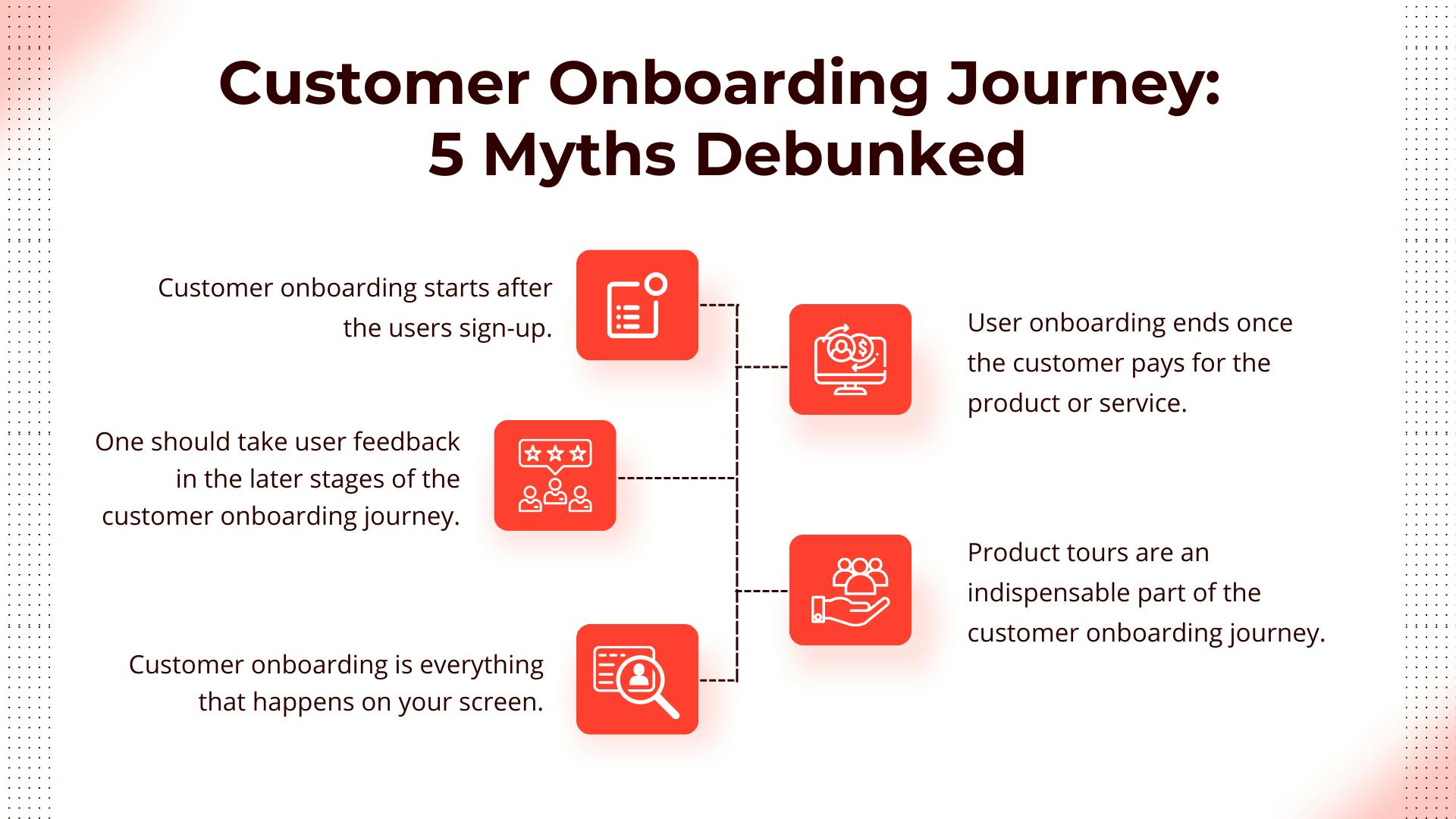
Unlocking Success: Debunking 5 Common Myths About Customer Onboarding Journeys

Ashutosh Gupta
Mar 28th, 20236 min readEdited on Jun 14th, 2023
What comes to mind when you think of the customer onboarding journey?
- Sign-ups?
- Automated product tours?
- Documentation?
- In-app notifications?
- Follow-up emails?
- All of the above?
There are many practices associated with customer onboarding that often lead to vague and varied definitions. For some businesses, it begins after user activation, but for some, it begins right at the start of user acquisition. Based on their understanding, they identify customer touchpoints and optimize CX to activate and retain more users.
This lack of standardization has resulted in prominent misconceptions associated with customer onboarding, and through this article, we hope to clear the air around some related myths.

Myth #1
Customer onboarding starts after the users sign-up
Many assume that user onboarding begins after the activation stage of the journey – when new users interact with the product for the first time - from where the customer success team guides them to discover product capabilities and value.
On the contrary, the onboarding begins from the acquisition stage, where users are sensitized with top-of-the-funnel articles, case studies, webinars, and ebooks and encouraged to sign up and create their accounts. Some of the customer touchpoints in the acquisition stage can be:
- Search Engine Result Pages (SERPs)
- A video ad on the Facebook feed
- The signup page
- Google ads
- Webinar
- Email invite
Users go through a series of experiences before they start using the product. With each experience, you can either elevate or plummet the value of your product in the eyes of users. For instance, a quick sign-up or verification process where users don’t have to manually fill in their information can significantly reduce the number of drop-offs.
Truecaller Verification SDK is an exciting solution in this space. It empowers businesses with phone-number-based user verification capability. Users can instantly sign-up with one tap and without any OTP dependency. Therefore, the solution innovates and optimizes a very critical step in the customer onboarding journey.
Myth #2
User onboarding ends once the customer pays for the product or service.
Does product onboarding end once the user becomes a paying customer? Is it fair to equate paying customers with happy customers if they are not deriving any value from the product?
Certainly not.
The product onboarding journey only ends when a customer is happy, fully equipped with the existing product capabilities, and inquisitive about future enhancements.
SaaS businesses often encounter a high volume of new, paying customers relinquishing their accounts soon after their first payment. As new users complete the initial onboarding steps and become customers, the customer success team should help them adopt new product capabilities and understand various use cases.
The end goal of user onboarding is not only to convert users into paying customers but to make sure they stick around for a long time and keep extracting value. It should bridge user acquisition and activation and eventually lead to user retention.
Myth #3
One should take user feedback in the later stages of the customer onboarding journey
It’s a myth that all unhappy users complain. In fact, most of them quietly drop off. Some of them find their own solutions or get so used to the product design that they don’t feel the need to complain. The end result? You miss out on the shortcomings of your customer onboarding process or product in general.
It’s better to get on the front foot right at the beginning by analyzing the user behavior across the onboarding stages.
- If customers haven’t completed the onboarding process, find out why.
- If they have, then ask about their onboarding experience.
You can even collect data without involving customers using the following tools:
i). Heat maps: They can help you analyze customers’ engagement patterns during the onboarding process using warm-to-cool color spectrums. For example - the steps on which they spent more time, the sections of your content they read the most or the links they repeatedly clicked.
ii). Session replays: As the name suggests, you can record and replay how customers interacted with your app. For instance, you’d know how much time customers spent on each section of your onboarding process.
There are also tools that can help you identify your at-risk customers - who sign up but are not part of your Daily Active Users (DAU) or Monthly Active Users (MAU).
Myth #4
Product tours are an indispensable part of the customer onboarding journey.
Many users associate customer onboarding with tedious product tours or walkthroughs, taking new users through different product features, settings, and capabilities. Most of these tours are automatically triggered and are too templatized to match the learning style of every user.
There are two key challenges with this kind of automatically triggered and templatized experience:
- It’s very difficult to time the pop-up to perfection.
Upon logging in, most users instinctively want to explore the platform or app on their own, and getting a walkthrough pop-up out of nowhere may create a distraction more than anything else.
Similarly, once the users are over that thrill of exploration, they look for intuitive guidance to fill the gaps in their product knowledge. Therefore, if you delay the pop-up too much, you will end up hurting the user experience.
- Users need more intuitive guidance than a pre-decided one
Users can take spontaneous actions and are bound by a script while going through such product tours. This may not suit their learning style and make them rush through the tour without gaining anything.
We recommend the following:
- Design product tours that address specific product friction (rather than designing generic product walkthroughs).
- If you want to go for automatically triggered product tours, keep them precise and punchy. Present them more like ads than tours.
- Create interactive self-service learning modules. And we have proof of this last point after analyzing over 15 million user interactions. The chart below is drawn from our According to Chameleon’s Product Tour Benchmarks report that studied 15 million user interactions, self-serve tours had higher completion rates than the automatically triggered ones.
Myth #5
Customer onboarding is everything that happens on your screen.
This myth can make your customer onboarding too automated – and take your focus away from things that happen behind the screen. Today it is very much possible to purchase from a company with zero human interaction. However, this also means that businesses run the risk of jeopardizing the customer connection.
Successful onboarding means having a holistic 360-degree view of how your product integrates with the customers’ objectives, not just the immediate goal. The approach should be to improve customers’ life as much as possible.
As rightly said, “People don’t buy products; they buy better versions of themselves.” Whether it is a blog subscription, gym membership, a new phone, or whatever–the purchase is backed by the emotion that this product will enhance my life in some shape and form.
Here we list a few ways to make your customer onboarding process more “human.”
- Create customer-centric goals that prioritize their needs over the company’s business objectives. In other words, understand and support your customers’ needs during sales calls instead of pushing your product's features.
- Enable your sales representatives to pass on all relevant customer information—their demographics, pain points, preferences, and dislikes—to your onboarding team. This way, they’ll know how to best frame the product to set customers up for a successful relationship. For example, if you know from your sales calls that a customer is more interested in certain product features than others, you can tailor your onboarding to focus more heavily on the features that most appeal to them.
You can learn more about Truecaller Verification SDK here
If you have any questions or feedback, feel free to reach out to our Developer Platform Team
References: Passwords & Authentication Consumer Trends Report